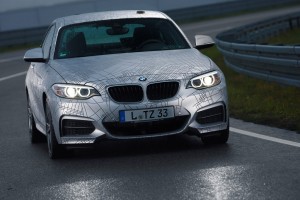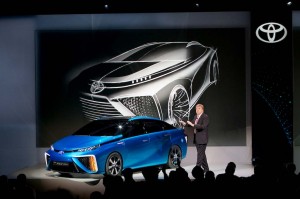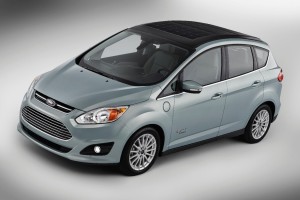While the Detroit Auto Show has traditionally been the New Year’s kickoff for the automotive industry, the annual Consumer Electronics Show has increasingly upended that role, this year eight different manufacturers trumpeting their presence in the North Hall of the Las Vegas Convention Center, hoping to connect with a new audience.
This year’s CES saw brands like Audi, Chevrolet, Toyota and Kia cover a wide spectrum of high-tech topics, from advanced lighting to in-car entertainment, as well as what has become one of the most talked-about technologies in some time: autonomous driving.
Audi even crossed the Atlantic Ocean with some 30 European journalists to present their news ahead of the Detroit auto show, while Mercedes and BMW also brought representatives of the automotive media to Las Vegas. Those, who have never attended CES were taken aback by the size of the largest trade show in Las Vegas, one that hosts 3,200 exhibitors who distribute some 20,000 new products. They will likely never complain of crowded car shows anymore.
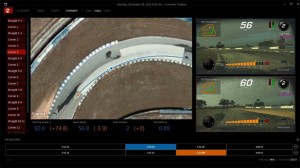
Data captured by the new Corvette PDR can be analyzed and viewed on a computer using the Cosworth Toolbox program.
BMW used CES to detail its state of autonomous driving, bringing attendees up to the nearby Las Vegas Motor Speedway to watch as a 6-Series and a prototype of the upcoming M235i handled the big course in fully autonomously mode, braking, accelerating and even maneuvering a short slalom as if the Stig was at the helm. The two models even put on a reasonable demonstrating of driverless drifting.
Audi also had autonomous driving in mind as it began its own presentation with a driverless car pulling on stage, but the highlight of its news conference was the new Audi Sport Quattro Laserlight concept. A step beyond the LED lights only now becoming common in the automotive market, the show car’s laser headlamps can light up the road for nearly a third of a mile, far more than any competing technology, Audi officials crowed, promising to put laser lamps into an as-yet undisclosed new product.
(Click Here to check out the Audi Laserlight concept.)
But Audi will not be the first to get laser light into a production vehicle. The honor goes their colleagues from Munich, who will show the production version of the BMW i8 with standard laser light during a show this spring.
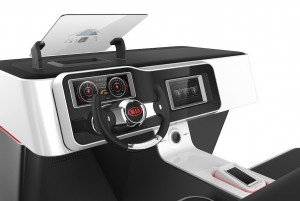
Kia's User-Centered Device (UCD) uses a wide-screen, head-up display to give drivers information such as speed, navigation or traffic information.
In keeping with CES tradition, connectivity was a big topic. Chevrolet used its time in the spotlight to announce it would begin building new 4G LTE hotspots into virtually all of its products, starting in 2015, in partnership with AT&T.
(For more on Chevy’s connectivity plans, Click Here.)
(Chevy also debuted a new Performance Data Recorder with internal camera, microphone and telemetry system that it will begin offering on the Corvette Stingray and new Corvette Z06 later this year. Click Here for more.)
One of the more intriguing developments at CES was news that Google would gain a foothold in the fast-growing infotainment world, Audi, General Motor, Honda and Hyundai signing on with the new Open Automotive Alliance that will be based around the tech giant’s Android operating system.
(To see what Google has in mind with its auto project, Click Here.)
Kia, meanwhile, showed a couple of concepts at the Consumer Electronics Show in Las Vegas that can be used with its UVO system. The first is a User-Centered Device (UCD). The UCD uses a wide-screen, head-up display to give drivers information such as speed, navigation or traffic information across 18 inches above the instrument cluster. It’s joined by a 12.3-inch TFT-LCD display that provides the data in 3-D.
(For more on Kia’s CES news, Click Here.)
Additionally, the system charges mobile devices wirelessly and uses hand-gesture recognition for additional information.
Speaking of connectivity, electric cars offer opportunities to get connected not only to your smartphone, but even the newest “wearable” tech devices. New is the Samsung Galaxy Gear, a smart watch developed with BMW, while Mercedes is offering something similar with the Pebble Smart Watch.
(Click Here for more on automotive smartwatches.)
Alternative power has almost become passé at CES, but Toyota generated buzz with the U.S. unveiling of its new FCV, a concept version of the hydrogen fuel cell vehicle it plans to put on the market in 2015. Unlike battery cars, with their limited range and long charging times, Toyota Senior Vice President Bob Carter promised the FCV will deliver 300 miles of range before needing a 3 to 5-minute fill-up.
(Click Here for more on the Toyota FCV.)
Toyota also brought two battery cars, the ultra compact electric i-Road and the FV2, the latter deemed a model for the connected future.
Ford showed that battery cars don’t have to be tied to the plug, meanwhile, unveiling the C-Max Solar Energi Concept, an extended-range electric vehicle that can alternatively draw its power from the sun. The prototype uses a new concentrator to increase the amount of solar energy it can capture – speeding up the recharge process significantly.
(Click Here for more on the Ford Solar Energi concept.)
CES show-goers had their attention turned back to the track by the FIA, the global motorsports sanctioning body, which demonstrated the new formula E race car. The FIA has given approval for a global championship series that will start next September in smoggy Beijing. The electrical race series will run from September 2014 through June 2015 and will be held in mega-cities across North and South America, Europe and Asia.
(Paul A. Eisenstein contributed to this report.)

